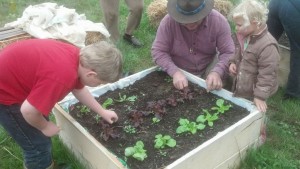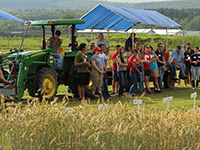Establishing Roles
Recruitment
Orientation
Preparation
Communication and Feedback
Retention
Appreciation
Every gardening project requires committed volunteers. Volunteers contribute a wealth of experience and enthusiasm. They also bring abundant skills, fresh ideas, and extra hands to help with garden activities. Volunteers often join because they care about the project and its participants. They may want to be more involved in their communities, meet new people, and “make a difference.” Perhaps they become involved because their children are in the program, or they want to be associated with a worthy community effort. Before you can effectively manage volunteers, it helps to know their motives, in order to sustain a fruitful relationship that builds your program while meeting their needs as well.
Whatever their reasons for becoming involved, the following are the major components to ensure success with volunteers, as identified by the National 4-H Foundation.
- Identify and recruit people with the competence and attitudes essential to accomplishing the goals of the program
- Select and place volunteers in roles that meet their needs, and yours
- Orient volunteers to the goals of the project and the role that they will play
- Train volunteers in the specific skills, knowledge, and attitudes necessary for them to successfully accomplish their tasks
- Utilize volunteers’ time and skills effectively
- Recognize and appreciate volunteers’ contributions
- Evaluate volunteers’ performance and provide useful feedback
- Help volunteers reach their desired goals within the project

Establishing Roles for Volunteers
Before recruiting, define the role you want volunteers to play in your garden program. Create a list of specific jobs with detailed descriptions. For example:
- Do you want volunteers who can be there on a weekly basis or just for special events?
- Do you want them to help plan and prepare garden programs?
- Do you just want them to help with the activities?
Keep in mind that people volunteer for different reasons, and any group of people will have a wide range of talents. If you communicate the jobs available for volunteers to complete, then they can determine whether your opportunities match their interests and skills. The time you spend preparing for volunteers and establishing clear responsibilities will help you create an effective and efficient volunteer team.
All volunteers want to feel that they are contributing in a meaningful way. Volunteers benefit from taking part in both menial and highly important tasks. Many volunteers will continue to be involved if they develop a sense of pride and ownership of the project and believe that the role they play is truly effective. Involve them in as much of the planning and decision-making as possible to foster a sense of ownership and independence. Although you will certainly need help with some “grunt work,” as long as volunteers know their efforts are helping the program, they will feel like valuable team members.
Certain parts of your garden design will require a skilled project leader to coordinate and complete construction. Find members of the garden team or school community to lead these specific projects, or, if necessary, find an outside expert to do the work.
top
Recruiting Volunteers
Once you know how you are going to use volunteers, begin the recruiting process. Look for volunteers who will encourage exploration and inquiry-based learning during garden activities and who will approach the garden with a fun and adventurous attitude. Think outside the box too. Volunteers lacking gardening experience can often be just as helpful as those with gardening experience. They are eager to learn new skills and–more often than not–have another useful skill to share. Think about the types of skills you might need from volunteers. These might include carpentry, engineering, landscape design, grant writing and event planning.
Try to recruit volunteers with a connection to the majority of garden participants’ backgrounds (be it ethnicity, neighborhood, culture, language). –Mark Miller, Education Manager at Franklin Park Conservatory and Botanical Gardens in Columbus, Ohio
Some volunteers will be available only for special events. For instance, a Boy Scout might develop an Eagle Scout project at your garden. Other volunteers–for example, a stay-at-home parent with a horticulture degree– may be available to help on a regular basis. Garden programs benefit from a diverse set of volunteers.
- Search for volunteers through local horticulture clubs (e.g, garden club members, college and university horticulture or sustainability clubs), “green industry” businesses (e.g. garden centers, landscape design firms), senior citizen organizations,
service organizations (e.g. Cooperative Extension Service Master Gardeners and 4-H, Rotary, Boy Scouts, Girl Scouts, AmeriCorps and FoodCorps), and local volunteer service programs. - Most schools find their strongest volunteers through parent groups. Reach out to parents in newsletters, on the school website, at parent meetings, and at open houses.
- The garden team members who help plan the garden will often be transformed into a core of strong volunteers.
- Recruiting older students to provide support for garden activities is another possibility. Elementary school students love to interact with middle school and high school students, and a mentoring relationship provides an excellent learning experience for both students involved.
As you reach out to potential volunteers:
- Schedule a special meeting to share information about the program and the opportunities available. If possible, hold this event during the same hours you typically need volunteer help. If people are available for the informational meeting at that time, they may well be available to volunteer in the future during the same time frame.
- Be sure to inform potential volunteers of your expectations, including time commitments and tasks. You may even consider writing a short volunteer job description to make sure the message is consistent. Be as specific as possible; give the dates and times their services will be needed.
- If you are working with a school garden, check your school’s policy on volunteer recruitment procedures. Most schools require volunteers to complete a background check with fingerprinting before service can begin. Individuals should be informed of this type of requirement during the recruitment stage.
- You may find it helpful for volunteers to complete a short application so you know a little more about their interests and backgrounds. Requiring an application is also a good way to get emergency contact information. A sample application can be downloaded from Cornell Cooperative Extension-Tompkins County (pdf).
- When people sign up or indicate an interest in volunteering, follow up with a phone call or in-person conversation to reiterate these expectations and give them a chance to ask questions. Not all individuals are a good fit with a school garden program, and it is best for both parties to figure this out during the recruiting stage rather than in the middle of the program.
- Consider making phone calls or sending personal invitations to individuals you have met who would be good volunteers or who have been recommended to you by others. Although mass recruiting is less time consuming, keep in mind that people like to be asked in person. It is a first step in making them feel important; it conveys respect and builds confidence.
The recruiting process may sound like a substantial undertaking, and it is. However, you will be rewarded by a supportive, dedicated, and informed volunteer group who will help sustain your garden efforts.
Volunteer Orientation
Use this Volunteer Orientation Checklist (pdf) to ensure you provide thorough information.
You will likely receive interest from people who want to volunteer once-in-a-while and others who want to participate regularly. It is helpful for all volunteers to be given an orientation. Depending on the size and scope of your project and the degree of interest from volunteers, you may find you need to provide this orientation several times throughout the year.
It is recommended to begin by orienting them to the program. Start by reminding them of your expectations, as you noted in your publicity and/or job descriptions. Next, brief them on policies. For example, let them know where to park, where to sign in, and what the procedures are for screening. Provide the group with a tour of the garden. They need to know things like the locations of bathrooms, where tools are stored, water sources, etc.
Provide regular volunteers with a log sheet to track the hours they spend helping the program. Volunteer hours can be documented as “in-kind” donation for grant purposes and demonstrate documented community investment in the project. (You may want to have regular volunteers log information about drop-in volunteers as well.) And, be sure to introduce regulars to key personnel, for example: the principal and office secretaries if you are working with a school project.
Volunteer Preparation
For volunteers who offer to help out regularly–and who you will want to encourage to take on more leadership roles–you will need to provide volunteer preparation to properly prepare them for their jobs and to assist with coordinating other volunteers. Always provide clear instructions as to what you want them to do and give them a chance to ask questions. To be successful, volunteers must know what is expected of them.
Provide background on any specific skills or knowledge needed to complete tasks by sending copies of your lessons a week ahead of time along with links to information on websites or a list of recommended books.
In addition to regular preparation and information related to activities and programs, it is a special treat for volunteers to attend “advanced preparation.” For instance, you can invite a guest speaker to introduce a new curriculum or teach volunteers a new skill. Depending on their level of involvement, certain volunteers might be invited to attend workshops conducted for educators by school districts and other organizations. Preparation is a powerful tool to motivate your volunteers and keep them excited about your program.
Volunteer Binder
In addition to in-person orientation and preparation, make a simple Volunteer Binder that includes all the information volunteers need to know in writing for later reference. Some ideas of what you may want to include in the binder are:
- Contact information – garden leaders, regular volunteers, school principal, custodian
- Who to call if there is an emergency – 911
- Pertinent health information about any regular volunteers or participating youth
- Volunteer hours log-sheet
- Codes for any locks needed for garden program
- Blank volunteer application forms
- Postcards with garden program information
- Planting/harvest log-sheets

Communication and Feedback
As previously mentioned, clear communication with volunteers is essential. When communication is poor, volunteers feel uninformed, unimportant, and under-appreciated. Disorganization and lack of communication will frustrate them, and they will quit. Here are a few communication tips for working with volunteers:
- Keep a good record of volunteers with up-to-date contact information and how they prefer to be contacted. It would be unfortunate to accidentally miss someone. This may be a simple spreadsheet or an online database. Use a method that works for you and easy to update.
- Establish a standard method of communication that is delivered consistently. This may be a weekly e-mail, a monthly newsletter, or a regular website posting. Choose a method that works well for you and your volunteers. By establishing a routine, you remind yourself to communicate with your volunteers, and in turn they have a place to go for the latest information. Remember, not all volunteers have Internet access all the time. Try to note which volunteers might prefer a phone call or letter.
- Create a written schedule of events that is accessible to all volunteers. It can be mailed out or posted on a website. Make sure you have an effective way to notify volunteers if any changes are made (via either e-mail or a phone tree).
- Hold a regular volunteer meeting either monthly or quarterly. Personal contact allows for more interactive discussions, and it is very important for volunteers to have a chance to provide you with feedback and suggestions for the program. This is also a great time for you to show your appreciation for their work. Provide snacks to share if possible.
- Provide members of the group with comments about their job performance. Although a formal evaluation may not be possible, volunteers need constructive feedback so they can learn and grow during this experience.
With your busy schedule, it may seem overwhelming to find time for this level of communication. If you feel that you cannot maintain strong communication, seek out a volunteer willing to assume this role. Communication is not a task that can be neglected even briefly without negative consequences. It is the key to a successful volunteer experience (for the volunteers and for you)!
top

Retaining Volunteers
All the suggestions mentioned thus far will contribute to the satisfaction of your volunteers and help you retain them. In a school setting, you will naturally lose volunteers as students graduate and families move, but by adopting good techniques, you can decrease the number of people who quit because of a negative volunteer experience.
If you are concerned about volunteer retention, take time to find out why people sign up. Volunteers often pitch in because they care about the project and its participants. Some may have children in the program with whom they want to spend more quality time; others may want to be more involved in their communities, meet new people, or make a difference. To keep volunteers interested and motivated, it is important for you to understand and meet their needs as much as possible while still meeting yours. For instance, if someone volunteers because she wants to spend time with her child, but you never assign her to work with her child’s group, she will not stick with it for long. Or, if someone volunteers in order to meet new people, and you always ask him to assist with individual preparation, he will get discouraged and quit.
Also remember that volunteers should support, not replace, educators. Although you may find volunteers who are willing to take on significant planning and educational delivery responsibilities, most volunteers will feel overwhelmed if left on their own to teach a full lesson, or will feel they lack proper guidance. Classroom teachers should be present during all garden activities.
As discussed earlier, not all individuals have the personalities and skills to be strong garden volunteers, so if you find your needs and their needs do not match, you may suggest other volunteer opportunities that would be better suited for them.
top
Volunteer Appreciation
- Thank your volunteers with simple thank you’s and smiles when they come to help or with a quick e-mail after activities.
- Give thanks with handwritten notes (from you and the students) or small gifts from the garden like pressed-flower bookmarks or herbal sachets.
- Recognize volunteers in newsletters and newspaper articles.
- Create awards or certificates for volunteers.
- Hold a special event each year focusing on volunteer appreciation, such as a ceremony in the garden or a luncheon. This event can be specifically hosted for garden volunteers, or you can work with other teachers to recognize volunteers in several programs.
Involve youth as much as possible in appreciation efforts. This helps them learn the importance of being grateful and showing respect for those who help them. It is an important life lesson that is often overlooked in our fast-paced society.
top












